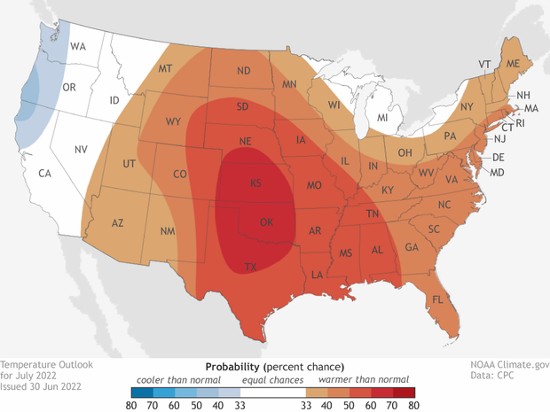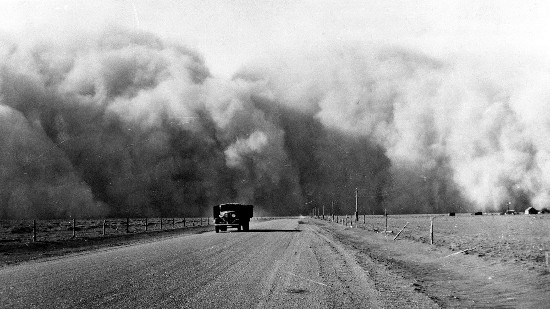Back in 2012, a documentary appeared on PBS describing the Dust Bowl of the 1930s that resulted from poor agricultural practices and a decade-long drought across the U.S. prairie states. I wrote about this historic event back then, a drought that lasted eight years and when combined with the Great Depression proved to be the perfect ecological and economic storm. Over-cultivated farmland, poor tillage practices, and a lack of rain caused 850 million tons of topsoil to blow away producing dust storms from the southern border of Canada to Texas and New Mexico. John Steinbeck in the novel, The Grapes of Wrath, wrote about the plight of those who lost their farms during the Dust Bowl and Great Depression and ended up becoming nomads searching for work and the means to survive.
Could we be facing a repeat of the Dust Bowl in the coming decades? Seeing this topic show up in contemporary literature again is no surprise. With another decade of data collected and more sophisticated climate models, it does not look like a good future for farming on the U.S. Prairies as the remainder of the century unfolds.
The latest article appears in the May 10, 2023 issue of Scientific American. It is written by Christian Elliott who describes the conditions in the current Prairies as being similar in many respects to what happened in the 1930s Dust Bowl. Elliott writes about a recent dust cloud that on May 1st caused a blizzard-like blackout on the Interstate that runs between Chicago and St. Louis leading to 72 vehicles colliding and seven deaths. Elliott describes a “perfect storm of factors” coming together to produce this tragic outcome.
What are these perfect factors that are leading to a reoccurrence of the tragedy of the 1930s Dust Bowl?
- Prolonged drought – Nearly half of the continental U.S. is experiencing drought while the other half of the country is getting soaked. Except for the recent rains and snow that temporarily reversed California’s megadrought, a trend to drier is expected to continue. Drought on the Prairies is a normal occurrence with scientific evidence showing regular occurrences going back centuries. But the extremes of a wetter East and drier West may be pointing to a more permanent weather model based on the data coming from the National Oceanic and Atmospheric Administration (NOAA).
- Soil erosion – Drier conditions plus farmers doing business as usual are contributing to the loss of topsoil. Two other factors add to this growing calamity. Warmer air is more turbulent with winds carrying away soil. And when it rains in drier conditions, the soil is too dry to retain the water which then runs off causing even more soil loss. Current research simulations predict that by 2070 soil erosion globally will increase significantly, by as much as 66% compared to 2015 contributing to an annual loss of 28 billion tons of topsoil. Current agricultural practices are as much to blame for this as the weather.
- Conventional agriculture – Soil erosion can be mitigated by sustainable land cultivation and the right government policies (see my next point). The simplest of changes from plowing to no-till agriculture, the planting of cover crops so that fields are never bare, and directed drip irrigation need to be adopted by Midwestern farmers. Conventional agriculture is leading to both land mismanagement and unsustainable use of freshwater resources.
- Policies pushing biofuel production – Growing biofuel crops in the Midwestern states is encouraged by state and federal government programs and farm incentives. But these crops (largely corn) are water hogs. And although the end product of turning corn into transportation fuels reduces the per unit greenhouse gas emissions that come from petroleum-based gasoline and diesel, the agricultural intensification required negates any pollution advantages gained. Ending subsidies and programs that encourage biofuel crops could in part reduce a return to Dust Bowl conditions.
- Depleted aquifers and misuse of surface water sources – Midwest farming, industry and urban use are exhausting freshwater supplies. Extensive irrigation to make up for a lack of precipitation is the current practice as this region of North America continues to dry out. The Ogallala Aquifer that underlies much of the Prairie states supplies as much as 46% of irrigated farmland in the region. The aquifer has been overdrawn for several decades with estimates that it will be 70% depleted by 2070. The Colorado and Mississippi-Missouri Rivers are the principal surface water sources and they too are being overdrawn. When you can’t replenish an aquifer or surface water sources then even a minor drought combined with rising air temperatures could contribute to further soil aridification and a new Dust Bowl.
- Climate change – Back in 2012, a NOAA climate model stated that the Mid-western U.S. may not suffer a “semi-permanent Dust Bowl.” But how a decade of new data has discounted that work with indications of a much more problematic climate future for the region stretching from the Canadian border to Texas and New Mexico. In 2022, North America’s mean temperature was 0.91 Celsius (1.64 Fahrenheit) higher than recorded means between 1910-2000 (see July 2022 NOAA forecast map below). The recorded mean temperature rise doesn’t paint the entire picture. Heatwave periods within the mean temperature rise are proving to be appreciably worse than any previously recorded periods, including the Dust Bowl 1930s. And what these heat waves do is create conditions where evapotranspiration sucks all the moisture out of the soil, and further induces hotter air temperatures. The climate models reflect this is less likely to be variability and much more a growing trend as the world’s atmosphere continues to warm.

We have the means to address these perfect factors. We can stop contributing to making the drought worse by adopting better land management, soil and water conservation, and farming practices. We can mitigate climate change by reducing the use of fossil and biofuels through electrification. We have the lessons of history to remind us that even with our advanced technologies and practices, ignoring nature leads to unintended consequences.










Dear Len,
I wanted to take a moment to express my appreciation for your insightful and engaging tech blog. Your in-depth analysis, industry knowledge, and ability to distill complex topics into accessible content have been invaluable to me as a reader. Your blog consistently provides thought-provoking articles and keeps me up-to-date with the latest advancements in the tech industry.
As I have recently started blogging in the technology space myself, I have found great inspiration in your writing style and content strategy. It would be wonderful to connect with you and seek your guidance as I navigate this exciting journey of blogging. Could you please let me know how I can contact you to discuss further?
Once again, thank you for sharing your expertise and passion through your blog. I look forward to hearing from you and continuing to follow your insightful work.
Best regards,
Aryan Pandey